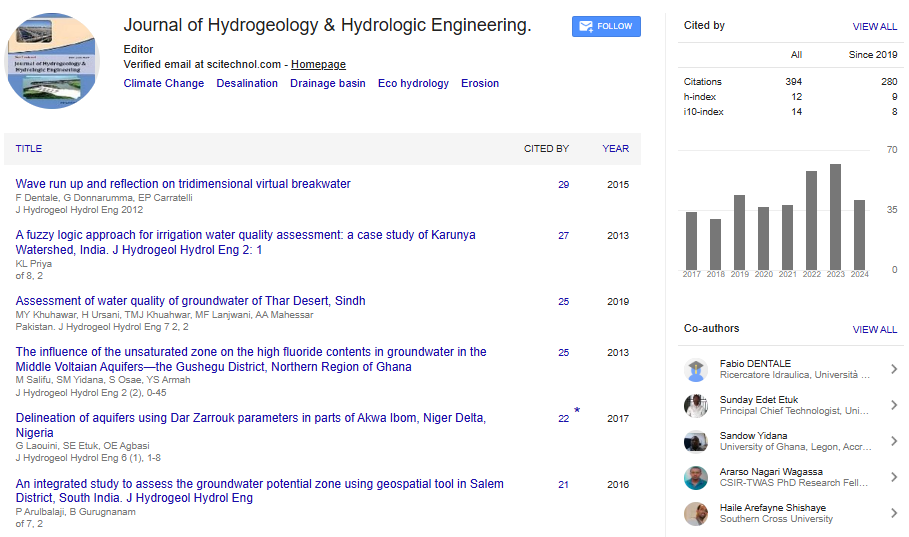Opinion Article, J Hydrogeol Hydrol Eng Vol: 13 Issue: 6
The Role of Remote Sensing in Modern Scientific and Environmental Applications
George Amankwah*
1Department of Applied Hydrology, Kyoto University, Kyoto, Japan
*Corresponding Author: George Amankwah,
Department of Applied Hydrology,
Kyoto University, Kyoto, Japan
E-mail: amankwahg@gmail.com
Received date: 26 November, 2024, Manuscript No. JHHE-24-154128;
Editor assigned date: 28 November, 2024, PreQC No. JHHE-24-154128 (PQ);
Reviewed date: 12 December, 2024, QC No. JHHE-24-154128;
Revised date: 20 December, 2024, Manuscript No. JHHE-24-154128 (R);
Published date: 27 December, 2024, DOI: 10.4172/2325-9647.1000358.
Citation: Amankwah G (2024) The Role of Remote Sensing in Modern Scientific and Environmental Applications. J Hydrogeol Hydrol Eng 13:6.
Description
Remote sensing has emerged as a fundament of modern science, offering unparalleled insights into Earth's natural and human-made systems. By utilizing advanced sensors aboard satellites, drones and aircraft, remote sensing collects data about Earth's surface without requiring direct contact. This technology has revolutionized fields such as environmental monitoring, urban planning, agriculture and disaster management.
One of the most significant contributions of remote sensing is in environmental monitoring. Satellite imagery enables the tracking of deforestation, desertification and glacier retreat, helping scientists gauge the impacts of climate change. For example, multi-temporal analysis of forested regions can detect changes in vegetation cover, while thermal imaging can monitor sea surface temperatures, a key indicator of global warming. Remote sensing also plays a vital role in wildlife conservation, providing data on habitat changes and migration patterns.
In agriculture, remote sensing is a game-changer for precision farming. By analyzing multispectral and hyperspectral images, farmers can assess crop health, soil moisture and nutrient levels. This information allows for targeted irrigation and fertilization, optimizing yield while reducing resource wastage. Additionally, early detection of pest infestations through remote sensing minimizes crop losses, ensuring food security for growing populations.
Urban planners and policymakers benefit immensely from remote sensing data. High-resolution satellite images aid in mapping urban sprawl, monitoring land-use changes and designing efficient transportation networks. Remote sensing also supports the assessment of air and water quality in urban areas, ensuring compliance with environmental standards. Moreover, during construction projects, the technology helps identify suitable locations and assess the potential environmental impacts.
Another precarious application of remote sensing lies in disaster management. Timely satellite data assists in predicting and qualifying the effects of natural disasters such as floods, earthquakes and hurricanes. For instance, remote sensing enables the detection of early flood signs by analyzing changes in water levels and land saturation. After a disaster, it provides rapid damage assessments, guiding relief efforts and resource allocation.
Remote sensing is equally transformative in the field of hydrology. Monitoring water bodies, including rivers, lakes and reservoirs, is essential for sustainable water resource management. Remote sensing technologies offer real-time data on water levels, quality and sedimentation, ensuring effective decision-making. This is particularly essential in regions prone to water scarcity, where efficient management can prevent conflicts and ensure equitable distribution.
The mining and oil industries also control remote sensing for exploration and monitoring. Satellites equipped with radar and thermal sensors identify mineral deposits, oil reserves and geothermal hotspots. Additionally, remote sensing aids in environmental compliance by tracking the ecological impact of mining activities and ensuring reclamation processes are effective.
Despite its many benefits, the field of remote sensing is not without challenges. High-resolution sensors and data acquisition systems are expensive, limiting access for smaller organizations and developing nations. Furthermore, interpreting remote sensing data requires expertise and sophisticated software, posing barriers to entry. Issues of data privacy and security also arise, as high-resolution imagery can inadvertently reveal sensitive information.
Future advancements in remote sensing hold the promise of overcoming these limitations. Innovations like miniaturized sensors, AI-driven analytics and enhanced data-sharing platforms are democratizing access to remote sensing technologies. Emerging trends such as the integration of Internet of Things (IoT) devices and remote sensing will further enhance the technology's capabilities, offering real-time, localized data across various sectors.
In conclusion, remote sensing stands as a transformative tool that transcends traditional boundaries of science and technology. Its applications across diverse fields highlight its significance in addressing pressing global challenges. As innovations continue to make remote sensing more accessible and accurate, its role in shaping a sustainable future will only grow. By connecting the power of remote sensing, humanity can better understand and manage the complex systems that define our planet.
 Spanish
Spanish  Chinese
Chinese  Russian
Russian  German
German  French
French  Japanese
Japanese  Portuguese
Portuguese  Hindi
Hindi 
